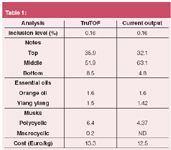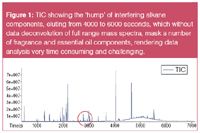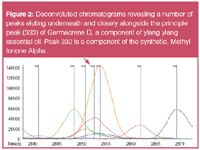Unravelling the Complexity of Fragrances in HPC* Products Using TruTOF GC–TOF-MS with Automated Data Deconvolution
The Application Notebook
The composition and analysis of fragrance components in home and personal care (HPC) products is very complex and unquestionably time consuming.
Nick Jones,1 Marcel Kneepkens,1 Izabela Malyszko,1 Sjaak de Koning2 and Lorraine Kay,2
1 Global Fragrance Centre, Unilever Research and Development, Port Sunlight, UK,
2 LECO European Technical Centre (ETC), Separation Science, Mönchengladbach, Germany.
Introduction
The composition and analysis of fragrance components in home and personal care (HPC) products is very complex and unquestionably time consuming.
Traditionally, significant GC–MS time may be consumed by running multiple separations using different phases. The resulting chromatograms are subject to labour intensive data interpretation, using retention index and mass spectral libraries, to accurately resolve and quantify the composition of perfume raw materials, including essential oils in the products.
Now, a new analytical approach has been evaluated. Using a LECO TruTOF GC–TOF-MS, with automated true signal data deconvolution, it is possible to significantly increase the throughput of such analyses using single separations. Additionally, in some cases where either there are a lot of interferences from the matrix or a complex mixture of essential oils, the ability to deconvolute full range mass spectra provides extra information. This will also increase our ability to accurately characterize and interpret our data to further unravel the complexity of fragrances in such products.
A skin care lotion, containing a relatively complex perfume including a number of essential oils was chosen to assess the ability of LECO TruTOF GC–TOF-MS. The goal was to increase both the throughput and quality of output, compared to the conventional multi-run analysis approach described. The skin care lotion analysed, was particularly appropriate, because of the presence of a high level of alkane (petroleum jelly) components. Such materials are significant interferences in fragrance analysis, as a result of their similarity in polarity and volatility to a high number of middle and base note perfume components.
Sample Selection and Introduction
A solvent extraction and proprietary clean-up procedure was used to extract perfume components from the skin lotion. Internal standards were added prior to the extraction/clean-up process for quantification purposes. The resulting sample was then concentrated by Vigreux distillation for analysis. Analysis of the sample was then performed by the traditional multi-phase/run approach described, using single quadrupole GC–MS systems, as well as by a single separation using a LECO TruTOF GC–TOF-MS system.
Results
Analysis of data collected using the existing 2-separation, single quadrupole MS measurements, processed manually, was compared to data collected from a single sample injection and separation using the TruTOF GC–TOF-MS system. This data was automatically deconvoluted using LECO's ChromaTOF software and incorporated Unilever R&D, Global Fragrance Centre mass spectral fragrance libraries.

Table 1
The output of the TruTOF analysis was compared to that of the standard, more time consuming fragrance analysis, which as a fully validated and well used procedure, provides an excellent benchmark. Key outputs from the analysis of fragrances in HPC products are inclusion levels, top, middle and base notes, essential oils, musks and approximate costs (as shown in Table 1). Therefore, measures of these were chosen for the comparison. The single injection TruTOF approach compared very favourably with the standard approach. In addition to this, a number of additional musk and essential oil components were identified underneath the 'hump' of alkane interferences.

Figure 1
The TIC trace in Figure 1 does not lend itself to easy interpretation. However, Figure 2 shows a zoom of the mass traces that are hidden under the TIC and seen following the automated deconvolution data processing methods. The deconvoluted chromatograms also reveal a number of peaks eluting underneath and closely alongside the principle peak (333) of Germacrene D, a component of ylang ylang essential oil. Peak 332 is a component of the synthetic, methyl ionone alpha and is represented by the pink mass trace below.

Figure 2
Conclusion
This study suggests that the use of a LECO TruTOF GC–TOF-MS system coupled with ChromaTOF deconvolution software, may provide an accurate and higher throughput alternative to other, multi-phase, multi-run separations that require significantly more resources, both in terms of man hours for data analysis and instrument operation time.

In addition, the ability to maintain full sensitivity over the full mass range and the ability to collect spectra at up to 80 spectra/second, yielding effective data deconvolution, may enable a richer and more informative data set and, to a great extent, eliminate the risk of losing important information during the analysis of HPC products that contain a high level of interferences, such as the skin lotion analysed here.

LECO European Technical Centre (ETC)
Marie-Bernays-Ring 31, 41199 Mönchengladbach, Germany
tel. +49 2166 687 104 or 107 fax +49 2166 687 148
E-mail: SepSci@leco.de
Website: www.leco.com

A Guide to (U)HPLC Column Selection for Protein Analysis
April 16th 2025Analytical scientists are faced with the task of finding the right column from an almost unmanageable range of products. This paper focuses on columns that enable protein analysis under native conditions through size exclusion, hydrophobic interaction, and ion exchange chromatography. It will highlight the different column characteristics—pore size, particle size, base matrices, column dimensions, ligands—and which questions will help decide which columns to use.
The Benefits of Custom Bonded Silica
April 1st 2025Not all chromatography resins are created equal. Off-the-shelf chromatography resins might not always meet the rigorous purification requirements of biopharmaceutical manufacturing. Custom bonded silica from Grace can address a wide range of separation challenges, leading to real performance improvements. Discover more about the latest innovations in chromatography silica from Grace, including VYDAC® and DAVISIL®.
5 Things to Consider When Selecting a Chromatography Silica
April 1st 2025Particularly in the pharmaceutical industry, drug purity isn’t just a goal – it’s essential for achieving safety, stability and efficacy. However, purification is easier said than done, especially with challenging molecules like DNA and RNA “oligonucleotides,” due in large part to their diversity and the range of impurities that can be generated during production. Enter DAVISIL® chromatographic silica, with a wide range of pore diameters and particle sizes to meet your specific application, performance and sustainability requirements. Before you choose the chromatography resin for your next purification application, take a look at these 5 considerations.
Automating Protein Purification: Efficiency, Yield, and Reproducibility
March 27th 2025Recent advancements in automated protein purification stress the importance of efficiency, scalability, and yield consistency. This eBook compares different purification platforms, highlighting their impact on downstream applications and demonstrating how automation enhances throughput and process control.














